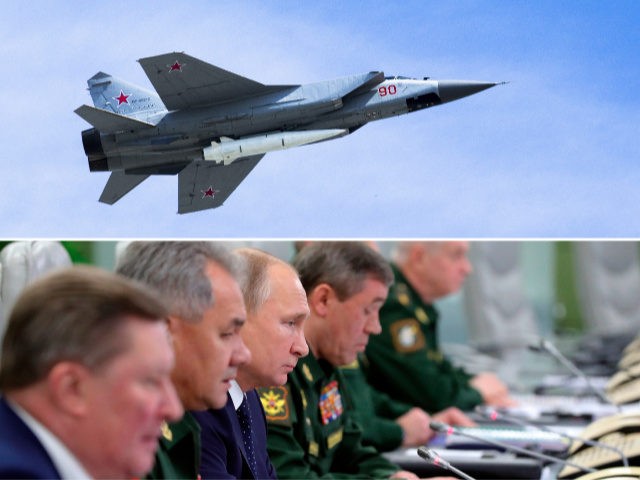The Pentagon is racing to build a defense against a growing hypersonic missile threat from China and Russia, according to military leaders and defense officials.
“The threat is rapidly changing. Today it’s becoming more prolific and more dangerous. The hypersonic threat is something that we’re paying keen focus to,” Lt. Gen. Samuel Greaves, director of the Missile Defense Agency, said February 1 at the Center for Strategic and International Studies (CSIS).
Hypersonic missiles are missiles that travel at or faster than Mach 5, or five times faster than the speed of sound. Currently, the U.S. does not have systems to effectively defend against them, and its two near-peer challengers, China and Russia, are fast developing them.
“They’re attacking the gaps and seams of our defense,” said Tom Karako, senior fellow and director of CSIS’s Missile Defense Project.
China is currently leading the field in hypersonic missile development, after the U.S. had developed the technology but decided not to pursue it, Pentagon officials said last month. The Defense Intelligence Agency assessed in a recent report that China was close to fielding a hypersonic missile.
“[W]e in fact pioneered all of that in the hypersonics world … we simply chose not to weaponize it, we didn’t think the world needed another arms race. Our adversaries have chosen differently,” Under Secretary of Defense for Policy John Rood told Breitbart News at a press conference on January 17.
“How long will it take us to build competing systems? You know, a few years,” he said. “So not infinitely far out, but not the day after tomorrow either.”
Rood predicted it would also take a similar timeframe to build a defense against hypersonic missiles. “You’ll start — you’ll see experiments in 2021, 2022,” he said. “I think you’ll see operational systems in the mid and latter part of the 2020s.”
The threat of hypersonic missiles drove the Pentagon to drop the word “ballistic” from its most recent iteration of the “Missile Defense Review,” which was released last month. The last review, in 2010, was titled, “Ballistic Missile Defense Review.”
“We are now recognizing the nature of missile threats to both the United States homeland, as well as to friends and allies abroad and our deployed forces go beyond just ballistic missiles,” said Deputy Under Secretary of Defense for Policy David J. Trachtenberg said February 1 at CSIS.
The Pentagon’s first step to meeting the threat will be a space-based sensor layer that would track hypersonic missiles anywhere around the world, from birth to death.
“Unlike a ballistic threat where the trajectory is predictable, the maneuvering capability of the hypersonic threat drives us [into] space, to use the vantage point of space to ensure we have birth to death custody of the threat from beginning to the end so we can optimize and direct our interceptors to interdict the threat at its most vulnerable point,” said Trachtenberg.
“So space, combined with ground, is where we want to be to make sure we know where the threat is,” he added.
Officials said the Pentagon has been working with Defense Advanced Research Projects Agency (DARPA) and primarily the Air Force on building out a space-sensor layer.
“At some point proliferating earth based sensors just won’t close the gap with what you need to do,” Rood said at the Hudson Institute on Thursday. “You can’t shoot what you can’t see.”
Greaves said the Pentagon has completed an analysis of alternatives (AOA) looking into what systems are needed for hypersonic defense, which should be released soon. He said some of the options include fast interceptors and directed energy, or laser.
“There’s some other options in there, and it’s essentially assessing the current suite of available interceptors to see if they’re fast enough to get to the target and win the tail chase,” he said. “But that AOA is now in final coordination and review within the department and should be released sometime soon.”
Greaves said the Pentagon has been looking at both available interceptors and potential new interceptors. “If it is determined after that coordinated review that the current suite will not meet the need, the threat is there, so we’ll need to develop something else if it’s decided to pursue a kinetic interceptor as the solution.”
It is not yet clear how much money the Pentagon will invest in a space-based sensor layer. The administration’s 2020 defense budget request was expected to be released early February, but has been delayed amid a fight between the White House and Democrats over funding the border wall.
Defense officials suggest the space-based layer will be built over time, adding on to the existing architecture in space. “Our intention is improve that capability substantially,” Rood said Thursday.
After improving sensor capabilities in space, the Pentagon will then focus on taking out hypersonic weapons, he said.
“The first priority will be in terms of tracking and detection, monitoring them. The first step in having … a defensive capability against that type of threat would be able to see it and track it and then later of course have the ability to deal with it,” he said.
He said the focus is on the “sensor side of that part of the mission right now.”
To learn more about the 2019 Missile Defense Review, watch:

COMMENTS
Please let us know if you're having issues with commenting.